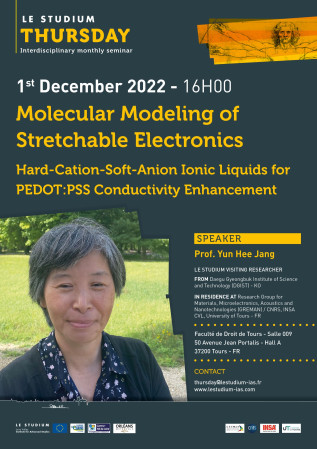Yun Hee Jang

From
Daegu Gyeongbuk Institute of Science and Technology (DGIST) - KO
In residence at
Research Group for Materials, Microelectronics, Acoustics and Nanotechnologies (GREMAN) / CNRS, INSA CVL, University of Tours - FR
Host scientist
Yves Lansac
BIOGRAPHY
Yun Hee JANG received B.S. (1990), M.S. (1992), and Ph.D. (1995) in Physical Chemistry from Seoul National University, Seoul, Korea. After working at Caltech (Pasadena, USA) as Postdoctoral Scholar/Researcher until 2005 and at GIST (Gwangju, Korea) as Assistant/Associate Professor of Materials Science & Engineering until 2016, she is now working at DGIST (Daegu, Korea) as Professor of Energy Science & Engineering, where she has also served Department Chair (2018-2019) and Associate Vice President for Academic Affairs (2019-2021). Her research group, Curious Minds’ Molecular Modeling (CMMM) Laboratory, employs multiscale methods of computational chemistry (quantum mechanics, molecular dynamics, and Monte Carlo) for molecular-level understanding of structures and functions of various materials at interfaces.
PROJECT
Molecular modeling of stretchable electronics
A water-processable (therefore mass-producable and environmentally benign) conducting polymer, PEDOT:PSS, attracts great attention as flexible, lightweight, ductile, transparent, and thermoelectric organic semiconductor and electrochemical transistor, which is ideal for various electronic devices such as organic LED, solar cell, thermoelectric generator, self-powered implantable sensor/actuator, and ultimately artificial skin.
However, so far, solution-processed PEDOT:PSS films, contrary to vapor-deposited PEDOT crystals, show much lower electrical conductivity and charge mobility than its inorganic counterpart (indium tin oxide). In pristine PEDOT, two types of electrostatically-bound polymers of different lengths, short PEDOT and long PSS, form granular domains, in which hydrophilic-but-insulating PSS encapsulates conducting-but-hydrophobic PEDOT, hindering network formation of large conducting PEDOT domains. It makes PEDOT:PSS water soluble and thermally stable but poor in conductivity and mobility. Dramatic (up to 5000-fold) improvement of PEDOT:PSS conductivity has been achieved by ionic liquid (IL). Various observations, both experimental and computational, indicate a mechanism in which an ion exchange between PEDOT:PSS and IL (A:X) triggers PEDOT-PSS separation and forms large PEDOT domains decorated by IL anions X.
This mechanism combined with a classic hard-soft-acid-base theory leads to a design principle that ILs or ionic salts with hydrophilic (hard) cations (acid) and hydrophobic (soft) anions (base) favor such processes, as confirmed by our experiment. Moreover, this experiment demonstrates a dramatic improvement of not only morphology and electric conductivity but also mechanical property (elastic modulus and damage strain) of PEDOT:PSS treated with such ILs.
In this project, we investigate the molecular origin of such IL-induced improvements in elastic modulus of PEDOT:PSS by carrying out density functional theory calculations and molecular dynamics simulations on atomistic models mimicking IL-treated PEDOT:PSS thin films deposited from its aqueous solution.
Publications
Final reports
A theoretical prediction of favorable ion exchange between PEDOT:PSS and hard-cation-soft-anion ionic liquids (IL) is confirmed experimentally and computationally by treating PEDOT:PSS with a new IL composed of an extremely hard protic cation MIM+ and an extremely soft anion TCB–. This protic IL significantly improves both conductivity and stretchability of PEDOT:PSS, outperforming its aprotic counterpart, EMIM :TCB, which has been the best IL employed for this purpose so far. This electrical and mechanical enhancement is speculated as a result of the aromatic and protic cation MIM+ which does not only provide efficient ion exchange with PEDOT:PSS but also serves as a molecular glue holding together multiple PEDOT domains by strong ionic as well as hydrogen bonds, because washing MIM+ out of the film degrades the stretchability while keeping the morphology. Our results offer molecular-level insights on the morphological, electrical, and mechanical properties of PEDOT:PSS and a molecular-interaction-based enhancement strategy for intrinsically stretchable conductive polymers.

